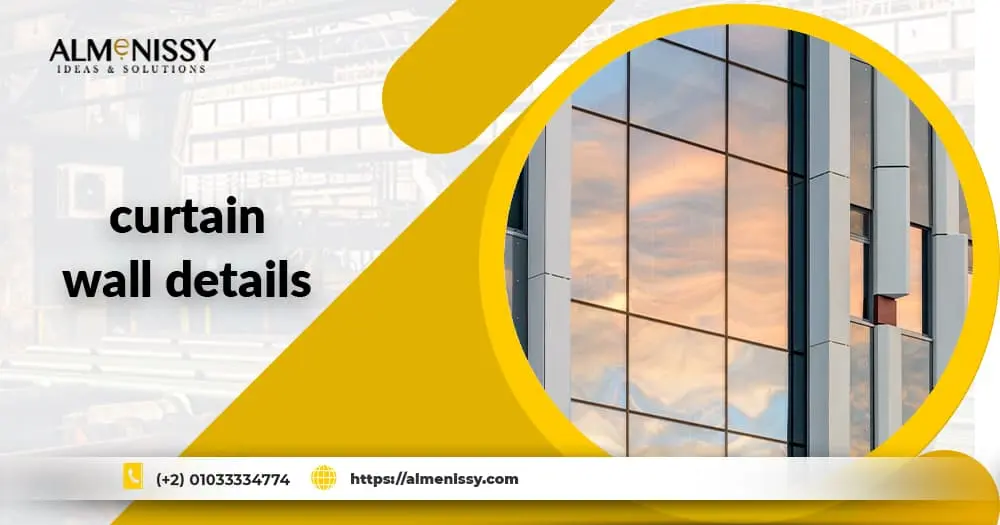curtain wall details are a fundamental component in modern architecture, providing an elegant solution for enclosing buildings while allowing for ample natural light and aesthetic versatility. Unlike traditional load-bearing walls, curtain wall details are non-structural and primarily serve to keep the weather out and the occupants in.
They are typically constructed using a combination of materials such as glass, aluminum, and steel, creating a thin, lightweight facade. Detailed design and construction of curtain walls involve a meticulous understanding of structural dynamics, thermal performance, moisture control, and aesthetic considerations, ensuring that they not only enhance the visual appeal of a building but also contribute to its overall performance and sustainability.
Table of Contents
Curtain wall advantages
curtain wall details offer several advantages, making them a popular choice in modern architecture:
1. Aesthetic Appeal:
curtain wall details provide a sleek, modern look with extensive use of glass and other materials, enhancing the overall appearance of buildings.
2. Natural Light:
The extensive use of glass in curtain walls allows for abundant natural light, reducing the need for artificial lighting and creating a more pleasant interior environment.
3. Energy Efficiency:
Advanced glazing and insulation techniques can make curtain walls energy-efficient, reducing heating and cooling costs by improving thermal performance.
4. Weather Resistance:
curtain wall details are designed to resist water and wind infiltration, protecting the building’s interior from the elements.
5. Flexibility in Design:
curtain wall details offer great design flexibility, accommodating a variety of shapes, sizes, and materials, and allowing architects to create unique and innovative building facades.
6. Reduction of Building Weight:
Being lightweight compared to traditional masonry walls, curtain walls reduce the overall weight of the building structure.
7. Ease of Installation:
Many curtain wall systems are prefabricated, which can speed up construction times and improve the precision and quality of installation.
8. Enhanced Views:
The extensive use of glass provides unobstructed views of the exterior, enhancing the experience for building occupants.
Curtain wall details
curtain wall details are non-structural, exterior cladding systems used in buildings, particularly in high-rise and commercial structures. They are designed to protect the building from external elements while allowing natural light to penetrate the interior. There are three main types of curtain wall systems: stick-built, unitized, and semi-unitized.
What types of glass are used in curtain walls?
Several types of glass are used in curtain wall details to meet various performance and aesthetic requirements. Here are the most commonly used types of glass in curtain wall details:
1. Annealed glass:
- Description: Basic float glass that has been slowly cooled to relieve internal stresses.
- Applications: Used in areas where strength and safety are not primary concerns.
- Drawbacks: It can break into large, sharp pieces, posing a safety risk.
2. Tempered glass:
- Description: Heat-treated to increase its strength.
- Applications: Commonly used in areas where safety is a concern, such as doors, windows, and facades.
- Advantages: Stronger than annealed glass and provides better safety.
3. Laminated glass:
- Applications: Used in areas requiring safety and security, such as skylights, floors, and facades.
- Advantages: Holds together when shattered, providing enhanced safety and security. Also offers sound insulation and UV protection.
4. Insulated glass units (IGUs):
- Description: Composed of two or more glass panes separated by a spacer and sealed to create an insulating air or gas-filled space.
- Applications: Used to improve thermal performance and energy efficiency in buildings.
- Advantages: Reduces heat transfer, enhances energy efficiency, and improves acoustic insulation.
5. Low-Emissivity (Low-E) Glass:
- Description: Coated with a microscopically thin, transparent layer that reflects infrared energy while allowing visible light to pass through.
- Applications: Used to enhance energy efficiency in building facades.
- Advantages: Reduces heat gain or loss, improves energy efficiency, and minimizes UV light penetration.
What types of curtains wall?
curtain wall details are integral components of modern architectural design, offering versatility and functionality in building envelope systems. Two main types of curtain wall systems are commonly used:
1. Stick system:
- Assembled on-site, piece by piece.
- Offers flexibility in design adjustments during installation.
- Requires more time and precision during installation, potentially leading to higher labor costs.
2. Unitized system:
- Prefabricated panels assembled off-site and installed as units.
- Faster installation with higher quality control.
- Less flexibility for on-site adjustments, but lower labor costs over the project’s duration.
These systems can incorporate various materials such as glass, aluminum, steel, and composites. Additionally, curtain walls can be customized with features like thermal breaks, insulated glass units, low-emissivity coatings, reflective or tinted glass, and spandrel panels to enhance energy efficiency, aesthetics, and performance.
The choice between stick and unitized systems depends on factors such as project timeline, budget, design complexity, and desired level of customization. Both offer unique advantages and can be tailored to meet the specific requirements of each architectural project, contributing to the creation of visually striking, energy-efficient, and sustainable building facades.
Conclusion
In conclusion, the intricate details of curtain wall details play a crucial role in modern architecture, blending functionality with aesthetic appeal. These non-structural facades offer significant advantages, including enhanced natural lighting, energy efficiency, and design flexibility. According to almenissy company, by meticulously addressing aspects such as structural integrity, thermal performance, and moisture control, curtain wall details ensure both the durability and comfort of building interiors. As technology and materials continue to advance, curtain walls are poised to remain a vital element in innovative and sustainable building design, shaping the skylines of the future.
FAQ
What is a curtain wall?
A curtain wall details is a non-structural outer covering of a building that is typically made of lightweight materials like glass, aluminum, and steel. Unlike traditional walls, curtain walls do not bear any load from the building's roof or floors. Instead, they are designed to resist weather elements, protect against wind and water infiltration, and enhance the aesthetic appeal of the structure.
What is the most common curtain wall?
The most common type of curtain wall system used in modern architecture is the unitized system. In this system, prefabricated panels are assembled off-site and then transported to the construction site for installation as complete units. This method offers several advantages, including faster installation, higher quality control, and reduced labor costs compared to stick-built systems.


